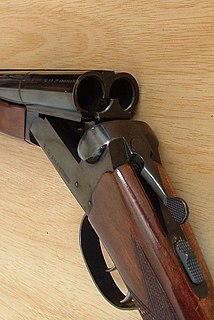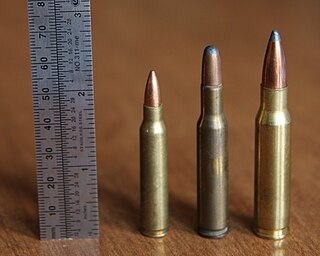
In firearms terminology, an action is the mechanism of a breech-loading weapon that handles the ammunition or the method by which that mechanism works. Actions are technically not present on muzzleloaders, as all are single-shot weapons with a closed off breech. Instead, the ignition mechanism is referred to

John Moses Browning was an American firearms designer who developed many varieties of military and civilian firearms, cartridges, and gun mechanisms – many of which are still in use around the world. He made his first firearm at age 13 in his father's gun shop, and was awarded the first of his 128 firearm patents on October 7, 1879, at the age of 24. He is regarded as one of the most successful firearms designers of the 19th and 20th centuries, and pioneered the development of modern automatic and semi-automatic firearms.
Winchester rifle is a comprehensive term describing a series of lever-action repeating rifles manufactured by the Winchester Repeating Arms Company. Developed from the 1860 Henry rifle, Winchester rifles were among the earliest repeaters. The Model 1873 was particularly successful, being marketed by the manufacturer as "The Gun that Won the West".

.22 Short is a variety of .22 caliber (5.6 mm) rimfire ammunition. Developed in 1857 for the first Smith & Wesson revolver, the .22 rimfire was the first American metallic cartridge. The original loading was a 29 or 30 gr bullet and 4 gr of black powder. The original .22 rimfire cartridge was renamed .22 Short with the introduction of the .22 Long in 1871.

The .218 Bee is a .22 caliber centerfire rifle cartridge designed for varmint hunting by Winchester in 1937. The cartridge was originally chambered in the Winchester Model 65 lever-action rifles, which may have ultimately led to its lack of popularity. The cartridge is named for the bore diameter of the barrel in which the cartridge is chambered rather than the usual practice in the United States of having the cartridge's nomenclature reflect in some way the bullet diameter.

The Model 1867 Remington rolling block rifle was the first rifle using metallic cartridges to be adopted by the Swedish and Norwegian armies. Nominally it had a caliber of 4 decimal lines, but the actual caliber was 4.1 Swedish decimal lines or 3.88 Norwegian decimal lines (12.17 mm), and it fired a rimfire round with a 12.615 mm lead bullet. The 12.17 mm caliber was chosen because the Swedish army had approximately 30,000 new muzzle-loading Model 1860 and breech-loading Model 1864 rifles in 12.17 mm caliber in stock, rifles that were suitable for conversion to Model 1867 rolling block rifles. With the exception of the first 10,000 rifles and 20,000 actions, which were made by Remington in the US, all Model 1867 Remington rolling block rifles and carbines were made under license in Sweden and Norway, by Carl Gustafs stads Gevärsfaktori and Husqvarna Vapenfabriks Aktiebolag in Sweden and by Kongsberg Vaapenfabrik in Norway, with the two Swedish manufacturers producing about 80% of the weapons.
The Remington Model 7600 is a series of pump-action, centerfire rifles made by Remington Arms. The Model 7600 is a progression from the original Model 760 pump-action rifle which Remington produced from 1952 to 1981. Production of the Model Six began in 1981 and was discontinued in 1987. Production of the Sportsman model 76 began in 1985 and was discontinued in 1987. Production of the model 7600 began in 1987 to present.
The Winchester Model 70 is a bolt-action sporting rifle. It has an iconic place in American sporting culture and has been held in high regard by shooters since it was introduced in 1936, earning the moniker "The Rifleman's Rifle". The action has some design similarities to Mauser designs and it is a development of the earlier Winchester Model 54.
Marlin Firearms Co., formerly of North Haven, Connecticut, is a manufacturer of semi-automatic, lever-action and bolt-action rifles. In the past, the company made shotguns, derringers and revolvers. Marlin owned the firearm manufacturer H&R Firearms. In 2007, Remington Arms, part of the Remington Outdoor Company, acquired Marlin Firearms. Remington currently produces Marlin-brand firearms at its Kentucky and New York manufacturing facilities.
The Remington Model 14 was a pump-action repeating rifle designed for the Remington Arms company by John Pedersen. It is part of a series of rifles that include the Remington Model 14-1/2 and the Remington Model 141.
The Winchester Model 71 was a lever-action rifle introduced in 1935 and discontinued in 1958.

The Remington XP-100 is a bolt-action pistol produced by Remington Arms from 1963 to 1998. The XP-100 was one of the first handguns designed for long-range shooting, and introduced the .221 Remington Fireball and 6mm-223 6×45mm. The XP-100 was noted for its accuracy and is still competitive today in the sport of handgun varminting, which it helped create.

The Browning BLR is a lever-action rifle manufactured by Browning Arms Company. It comes in many different variations and is chambered in calibers from .22-250 Remington to .325 WSM and .450 Marlin.
The Remington Model 30 is a US sporting rifle of the inter-war period based on the military P14/M1917 Enfield rifle action, which was manufactured for the British and US governments during World War I. Initial specimens used surplus military parts with some modifications in order to consume the stock of parts, though further modifications were made as production progressed and later rifles were produced from newly manufactured parts. Most early rifles were in the military .30-06 calibre used in the M1917 but it became available in a variety of chamberings. It was the first high-powered bolt-action sporting rifle produced by Remington.
The Remington Nylon 66 is a rifle manufactured by Remington Arms from 1959 to 1989. It was one of the earliest mass-produced rifles to feature a stock made from a material other than wood. Previously the 22-410 Stevens combination gun had been offered with a Tenite stock. The firearms market generally lacked experience with synthetic stocks, making the Nylon 66 a risky gamble for Remington. The model name was taken from the polymer of the same name.

The .25 Remington is an American rifle cartridge. A rimless, smokeless powder design, this cartridge was considered to be very accurate by period firearm experts and suitable for game up to deer and black bear.

The .32 Remington is an American rifle cartridge. A rimless, smokeless powder design, this cartridge was once considered to be suitable for game larger than deer and black bear. Similar contemporary cartridges include the rimmed .32 Winchester Special, a cartridge introduced by Winchester and offered as a chambering in Winchester's lever action rifles.
The Model 721 and Model 722 along with the later Model 725 variant are bolt-action sporting rifles manufactured by Remington Arms from 1948 until 1961. The 721/722 replaced the short lived Model 720. The Model 721/722 is considered to be one of the first modern, economically produced sporting rifles whose design largely continued with the subsequent and highly successful Model 700. Manufactured with high precision, it is known for exceptional accuracy. The bolt and receiver design, based on the Mauser action, is considered one of the strongest ever produced. Samples in excellent condition have become collectible.











